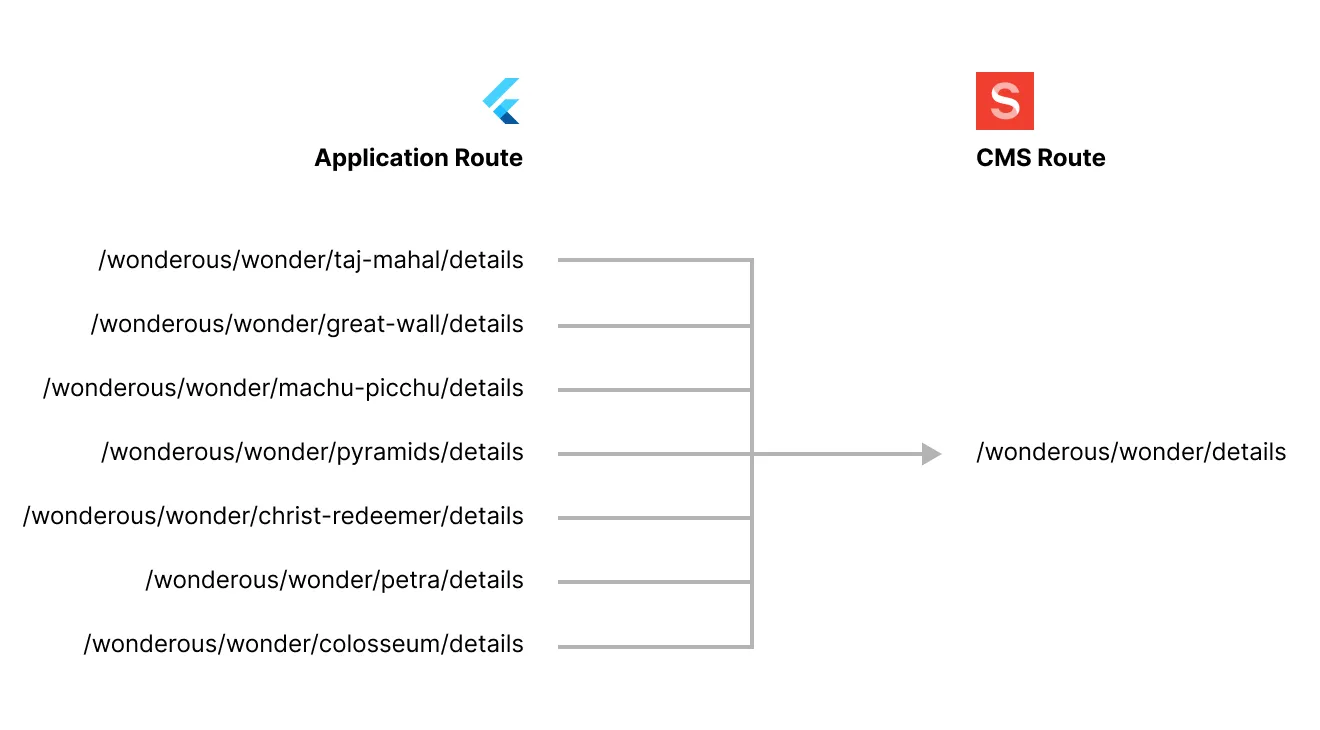Template Routes
Routes in the Vyuh framework allow you to define the structure of a page or a
dialog. The structure of a route is put together by assembling a set of content
items from the framework. These routes also have an equivalent on the Flutter
side, where they are rendered using an application router like the
GoRouter. Thus an application route like /home can have CMS route with
the same path that defines the structure of the page.

TL;DR;
Section titled “TL;DR;”Template routes are set up using the custom CMSRoute with a
cmsPathResolver parameter. This resolver function takes in an application
route path and maps it to a CMS path.
// CMS RoutesCMSRoute( path: '/wonderous/wonder/:wonder([^/]+)', redirect: (_, state) { if (state.topRoute?.path == null) { return '${state.matchedLocation}/details'; }
return '${state.matchedLocation}/${state.topRoute!.path}'; }, routes: [ StatefulShellRoute.indexedStack( branches: [ StatefulShellBranch( routes: [ CMSRoute(path: 'details', cmsPathResolver: wonderPathResolver), ], ), StatefulShellBranch( routes: [ CMSRoute(path: 'events', cmsPathResolver: wonderPathResolver), ], ), StatefulShellBranch( routes: [ CMSRoute(path: 'photos', cmsPathResolver: wonderPathResolver), ], ), ], builder: (context, __, shell) { // ... construct the Scaffold with bottom navigation ... }, ), ], ),
// ResolverString wonderPathResolver(String path) { return switch (path) { (String x) when x.contains(RegExp(r'/wonder/[^/]+/details')) => '/wonderous/wonder/details', (String x) when x.contains(RegExp(r'/wonder/[^/]+/events')) => '/wonderous/wonder/events', (String x) when x.contains(RegExp(r'/wonder/[^/]+/photos')) => '/wonderous/wonder/photos', _ => path };}Why do we need this?
Section titled “Why do we need this?”When you start out, you’ll most likely create a 1:1 mapping between an application route and a CMS route. But over time, you’ll realize that there will be more complex scenarios where multiple application routes can map to the same CMS route and provide the same structure. For eg., you could have multiple restaurant detail pages where the ID of the restaurant would be used to determine the restaurant, but the structure of the detail page would be exactly the same across all these restaurants.
This style of mapping multiple application routes to a single CMS route is referred to as a Template Route.
The template here refers to the route structure which remains the same across all these application routes.
Additionally, by leveraging the template routes, you also reduce the number of CMS routes you have to create in order to support your application. I think we’ll all agree that reusability is far better and superior than duplication. Template routes allow you to achieve that in a much more elegant fashion.
Template Routes in Wonderous
Section titled “Template Routes in Wonderous”If you haven’t seen the exposition on the Wonderous example, now would be a good time to take a look at it.
The main goal of the Wonderous example is show the different wonders of the world. Interestingly, it maps perfectly to the template routes that we’re discussing right now. The structure of every wonder page is pretty much the same. Instead of creating separate Wonder pages for each of the wonders, it’s probably best to create a single structural page that acts as the CMS route for all the wonders.
That’s a perfect use case for a template route, where we create a single CMS route and have multiple application routes mapped to it. Let’s see how it is done in Wonderous.
Wonderous Routes
Section titled “Wonderous Routes”The navigation inside the Wonderous app is quite simple. You start on the homepage from which you drill-down to explore each of the wonders. Each wonder is further broken down into:
- Details page (includes the details of the wonder)
- Photos page (shows you all the photos relevant to that wonder)
- Event page (shows all the events that have happened during the timeline of the wonder)
This can be seen in the navigation structure, shown below:

CMS Routes
Section titled “CMS Routes”Since the structure of the details page, the photos page, and the events page is
pretty much the same, we have created separate routes for them on the CMS. This
can be seen in the screenshot below. Notice that the paths of these pages end
with /wonder/details, /wonder/events, and /wonder/photos, indicating that
this is just a CMS template route.
As an aside, if we were duplicating this across
wonders, you would have to include the wonder (via an identifier) in the path
itself. Eg: /wonderous/wonder/taj-mahal/details. Doing this for every
wonder would just be cumbersome and unnecessary duplication.
The template-route approach really shines here.

Application Routes
Section titled “Application Routes”Each of the wonders have a specific identifier that helps us in
identifying the wonder on the CMS. When constructing the application route, we
will include this identifier in the route path itself and use that to map the
exact wonder page on the CMS.

The magic of mapping the application route to the CMS route happens in our
custom GoRoute called CMSRoute. We supply the cmsPathResolver
parameter which takes care of mapping the route. This can be seen in the snippet
below.
import 'package:feature_wonderous/api/wonder_client.dart';import 'package:flutter/material.dart';import 'package:go_router/go_router.dart';import 'package:vyuh_core/vyuh_core.dart' hide RouteBase;
Future<List<RouteBase>> routes() async { return [ CMSRoute(path: '/wonderous'), CMSRoute( path: '/wonderous/wonder/:wonder([^/]+)', redirect: (_, state) { if (state.topRoute?.path == null) { return '${state.matchedLocation}/details'; }
return '${state.matchedLocation}/${state.topRoute!.path}'; }, routes: [ StatefulShellRoute.indexedStack( branches: [ StatefulShellBranch( routes: [ CMSRoute(path: 'details', cmsPathResolver: wonderPathResolver), ], ), StatefulShellBranch( routes: [ CMSRoute(path: 'events', cmsPathResolver: wonderPathResolver), ], ), StatefulShellBranch( routes: [ CMSRoute(path: 'photos', cmsPathResolver: wonderPathResolver), ], ), ], builder: (context, __, shell) { // ... construct the Scaffold with bottom navigation ... }, ), ], ), ];}
String wonderPathResolver(String path) { return switch (path) { (String x) when x.contains(RegExp(r'/wonder/[^/]+/details')) => '/wonderous/wonder/details', (String x) when x.contains(RegExp(r'/wonder/[^/]+/events')) => '/wonderous/wonder/events', (String x) when x.contains(RegExp(r'/wonder/[^/]+/photos')) => '/wonderous/wonder/photos', _ => path };}Notice the use of the cmsPathResolver in lines 23, 28 and 33. All of them
point to the single function wonderPathResolver. The job of this handler is
take in the application route (via the path argument) and generate the
corresponding CMS-path.
The Regular Expression (RegExp) here is simply to check that an identifier exists in the application route path and then map to the corresponding CMS path.
The table below gives a few mappings in action.
| Application Route Path | CMS Route Path |
|---|---|
| /wonderous/wonder/taj-mahal/details | /wonderous/wonder/details |
| /wonderous/wonder/great-wall/events | /wonderous/wonder/events |
| /wonderous/wonder/machu-picchu/photos | /wonderous/wonder/photos |
Summary
Section titled “Summary”Template Routes are a great way to simplify the management of common Application Routes that all have the same visual structure.
By assigning all of them to the same CMS Route, you can ensure there is no
duplication. It is however necessary that you do this mapping by using the
CMSRoute with a custom cmsPathResolver. Doing so, gives you lot of
flexibility in managing the routes on your application.
Ask this question if you need a Template Route: same visual structure across
various parameterized application routes ? If yes, create a CMSRoute with a
cmsPathResolver. And you are good to go.

